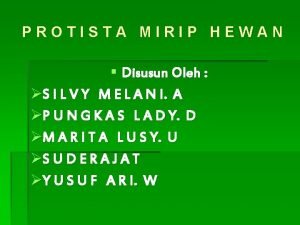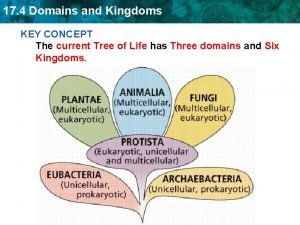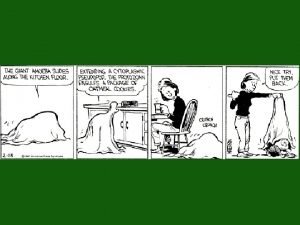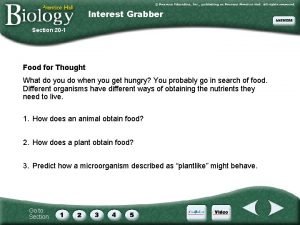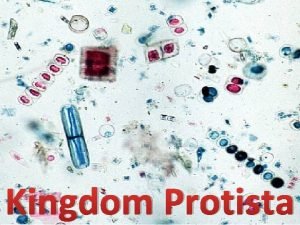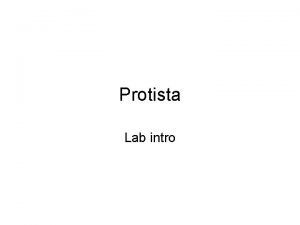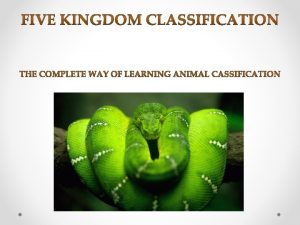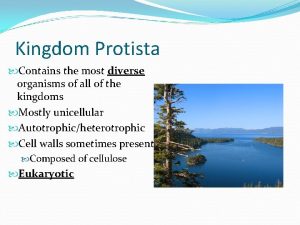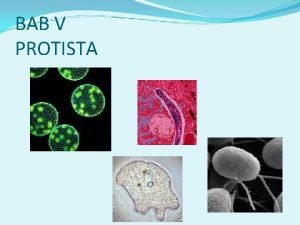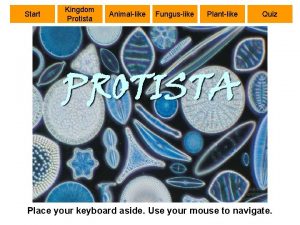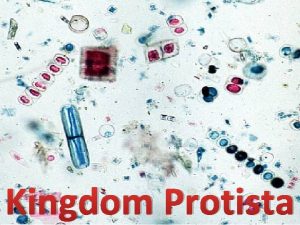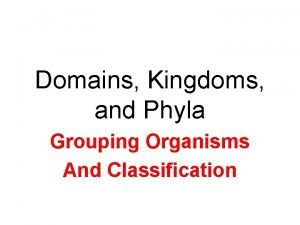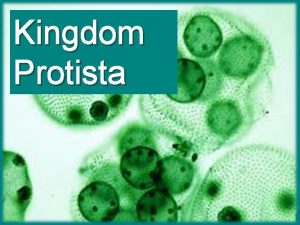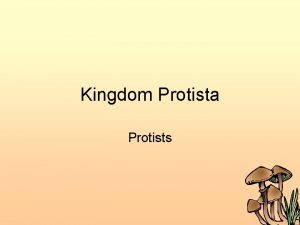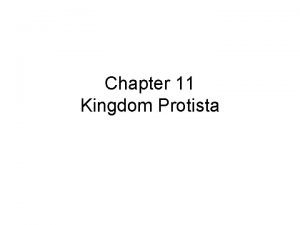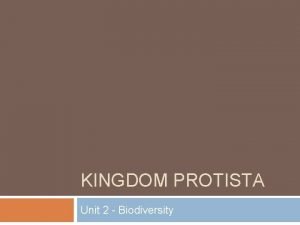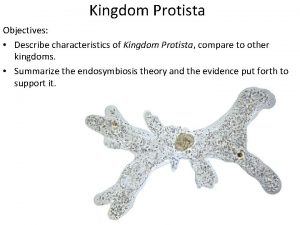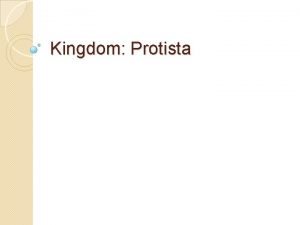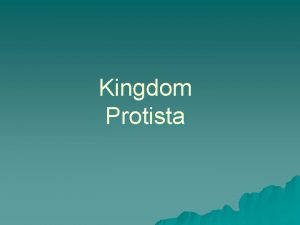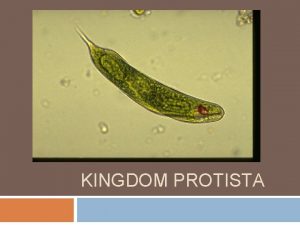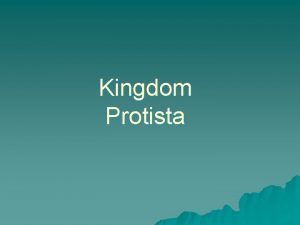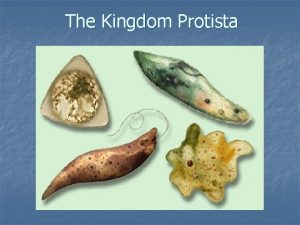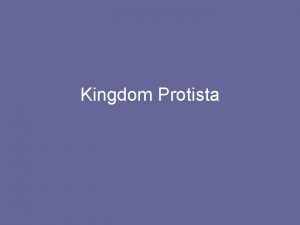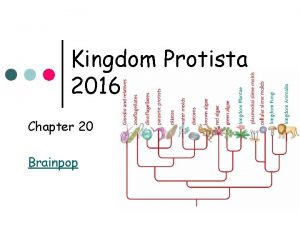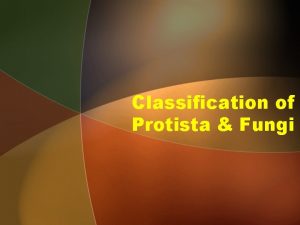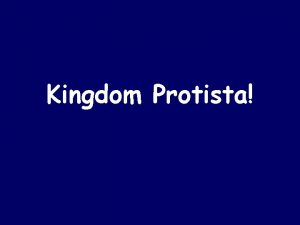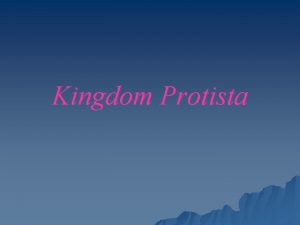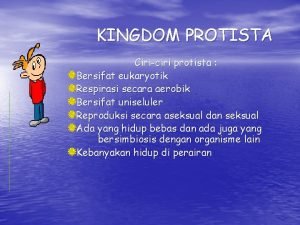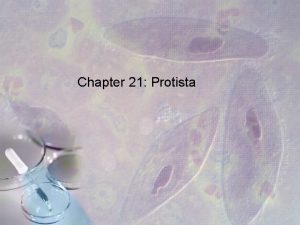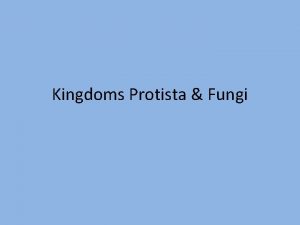Ch 20 PROTISTA The Kingdom Protista Defined more


























- Slides: 26

Ch 20 -PROTISTA

The Kingdom Protista Defined more by differences than similarities Not actual plants , animals or fungi Many _____________- and all eukaryotes • So diverse that many biologists suggest they should be composed of several kingdoms • • UNICELLULAR

• Classification based on : • 1)________________heterotrophs, autotrophs, decomposers and parasites • 2)Some classified by how they move nutrition

protozoans II. Animallike protists: __________________ • 4 Phylla: distinquished by modes of movement • __________use whiplike flagella; many are aquatic; many absorb food through cell membranes; many reproduce asexually and some sexually by meiosis • Sarcodines use _________for movement and feeding: example-amoebas-move by extensions of psuedopods: have food vacuoles; ________secrete calcium carbonate shells Zooflagellates pseudopods Foraminiferans



cilia Paramecium • Ciliophora move by hairlike _________; best known are of genus ______-has micronucleus and macronucleus, gullet or oral groove, anal groove, contractile vacuole to balance water content, reproduce asexually and sexually by conjugation • _______do not move; many parasites, reproduce by ____ sporozoans spores


• Diseases from protists • ****-___________-caused by Plasmodium and Anopheles mosquito, many forms resistant to drugs malaria

***Other Protistan diseases_Trypanosoma Carried by ______fly tsetse

****Amebic dysentery

Giardia

NONPARASITIC__Trichonympha-mutualism Digests wood for termite!!!!

III. Plantlike Protists -Unicellular algae Contain chlorophyll and undergo photosynthesis ***___________plantlike, have 2 flagella and no cell wall Euglenophytes


• _________________-yellow-green algae and golden brown algae • ____________-thin , delicate CELL WALLS OF SLICA-GLASSLIKE • DINOFLAGELLATES-half are photosynthetic and half are heterotrophic, some luminescent diatoms Crysophyta

• PHYTOPLANKTON-near surface of ocean and food source • Algal blooms that are massive depletion of nutrients and many cells die-an indicator of pollution

IV. Plantlike protists-red, brown and green algae • Red algae-_________-uses chloroplyll a and accessory pigments and can live at great depths; most multicellular and play role in coral reef • Brown algae____________-have chlorophyll a and c and an accessory pigment: largest and most complex of algae-kelp can grow 60 m in length Phaeophyta Rhodophyta


• Green algae-____________-have chlorophyll a and b; unicellular, colonial, and multicellular Chlorophyta

HUMAN USES OF ALGAE • • -animal and human food source -used in medications -ice cream -used in making plastics, waxes, deodorants, paints, transitors , lubricants, agar, toothpaste

V. Funguslike protists • Have centrioles and LACK chitin cell walls of regular fungus kingdom • Heterotrophs as decomposers • SLIME MOLDS-on forest floor-spore forming • WATER MOLDS-hyphae and spores-connected to great “Potato Famine”

Slime molds

Water mold


 More more more i want more more more more we praise you
More more more i want more more more more we praise you More more more i want more more more more we praise you
More more more i want more more more more we praise you Roman empire
Roman empire Capital of egypt during the old kingdom
Capital of egypt during the old kingdom Old kingdom middle kingdom new kingdom
Old kingdom middle kingdom new kingdom Nnn ruled
Nnn ruled A collection of well-defined object
A collection of well-defined object Kingdom protista multicellular unicellular
Kingdom protista multicellular unicellular 4 kingdoms of life
4 kingdoms of life Importance of kingdom protista
Importance of kingdom protista Section 20-2 animal like protists protozoans
Section 20-2 animal like protists protozoans Characteristics of kingdom protista
Characteristics of kingdom protista Struktur archaebacteria
Struktur archaebacteria Kingdom protista unicellular or multicellular
Kingdom protista unicellular or multicellular Protista lab
Protista lab Kingdom monera classification chart
Kingdom monera classification chart Which kingdom is most diverse
Which kingdom is most diverse Ciri ciri protista mirip hewan
Ciri ciri protista mirip hewan Kingdom protista quiz
Kingdom protista quiz Ciri protista
Ciri protista Kingdom protista characteristics
Kingdom protista characteristics Protista plantae fungi and animalia
Protista plantae fungi and animalia Monera, protista, fungi, plantae animalia
Monera, protista, fungi, plantae animalia Characteristics of protista kingdom
Characteristics of protista kingdom Protistans
Protistans What kingdom is archaea in
What kingdom is archaea in Protista
Protista







